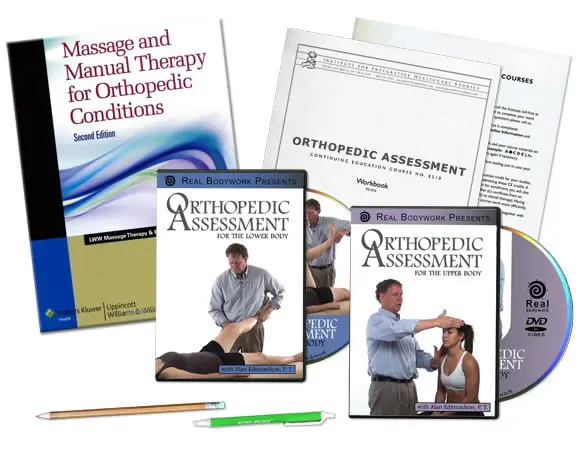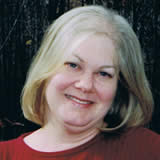
Learn classic assessment techniques for the neck, shoulder, elbow, ankle, knee, hip, spine and more. This course introduces massage techniques for orthopedic conditions, promoting the alignment of soft tissue relating to pain and dysfunction.
For clinical massage therapy, the course text contains brief descriptions of rationale behind orthopedic massage, mechanisms of injury to and repair of soft tissue, and anatomy of each body area.
The accompanying Upper Body and Lower Body course DVDs also provide 3-D animations to show exactly which structures are involved. Each section of the DVDs are divided into Subjective Assessment, Observation, Tests, Special Tests and Palpation, including:
You'll learn specific orthopedic conditions of the human body and discover how various massage therapy techniques can help ease pain and dysfunction of soft tissue. Specific pathologies regarding mobility, posture, injuries and diseases are included as examples of what can be addressed by massage therapists and which conditions are seen as contraindications. Several methods which help to promote proper alignment of soft tissue including wave mobilization, muscle energy technique and joint mobilization are defined, explained and demonstrated in the course materials.
The Orthopedic Assessment program will walk you through a logical progression of testing that will reveal the underlying pathology with crystal clarity.
The techniques and assessment provided in this program are meant to be practiced by licensed healthcare practitioners. Check your local laws to find out if performing these tests is within your scope of practice.
Diane Perkins
1/2/2025
Not only was the topic of this course highly engaging but the presentation of information in the book and on DVD were super well presented. I especially appreciated Eric Edmundson. For all his mild-mannered delivery, he just inspires confidence and you can tell he knows his subject! I would recommend this course absolutely. And now if you'll excuse me, I'm just going to go and apply what I've learned to troubleshooting a neck issue that has been plaguing me for some time. :) Happy Continuing Ed Study!
Casimir R. Szczap
12/16/2024
Very well done
Stephanie Limoncelli-Vealey, LMT
10/13/2024
Ashley Miller
9/20/2024
a very in depth and clear course
Emily Poole, LMT
8/3/2024

Linda Fehrs attended both the Swedish Institute of Massage Therapy and Hudson Valley School of Massage Therapy in New York – a state with some of the most rigorous licensing requirements in the U.S. – and also served as an instructor at the Hudson Valley School of Massage.
She is a professional member of the AMTA and the New York State Society of Medical Massage Therapists. Linda has actively practiced massage therapy in the Mid-Hudson Valley since 2002 with a focus on medical massage and massage for those with special needs, such as developmental and physical disabilities.
Ms. Fehrs has authored such courses as Build Your Massage Practice, Cancer & Massage, Women & Massage as well as Marketing Massage and the Economy.

Sean Riehl has been a bodyworker since 1998 when he completed his training program through the Body Therapy Institute in California and subsequently served as an instructor there. Certified in Lymphatic Drainage, Visceral Manipulation, Neuromuscular Therapy, Muscle Energy Techniques, Myofascial Release and Shiatsu, Mr. Riehl established Real Bodywork in 2000 producing high-quality, professional, instructional massage and yoga videos. With over 40 video titles, Real Bodywork is the preeminent producer of videos in the massage training industry.
Mr. Riehl is author, co-creator and instructor on various Institute courses including Neuromuscular Therapy & Advanced Deep Tissue, Lymphatic Drainage Massage, Myofascial Release, Advanced Anatomy & Pathology, Clinical Massage Therapy, Integrative Massage: Earth, Fire and Spirit, Nerve Mobilization and more.


Take our free online course: Ethics Refresher
We will not rent/sell your email to anyone.
You'll also receive our newsletter and special offers.
Thank you! An email will be sent to the address provided with instructions on how to enroll in this 1 CE hour course - FREE!
If you do not see our email within a few minutes of signing up, please check your Spam/Junk folders it may have been delivered there instead of your inbox.
If, by chance, you still have not received it within 5 minutes, please call us at 1-800-364-5722, Monday-Friday, between 9am-12:30pm and 1:30pm-5pm EST for assistance.